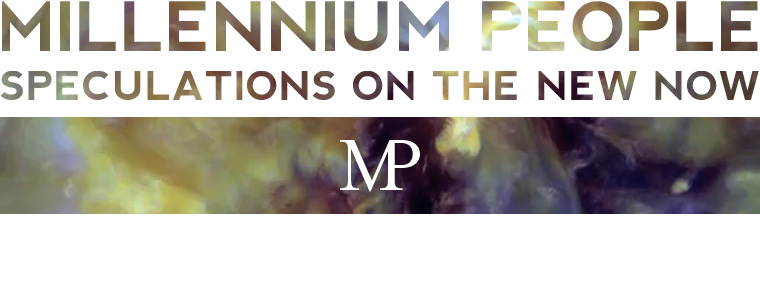
The giant shining face of Jim Ballard stared out at us, like some deity critically surveying his assembled congregation. Below this over-sized icon Nic Clear swayed back and forth on his feet, at times falling into a reverent chant as he picked up on some core Ballardian doctrine: the high priest behind his technological altar.
Nic, amongst other things, is the editor of a recent AD entitled “Architecture of the Near Future”, which began as an investigation into the influence of Ballard on contemporary architecture – and he began by answering the question: why “near” future? Conception necessarily precedes construction, so architecture is necessarily a profession founded in tomorrow’s work. It is, therefore, also necessarily utopian, in that it is always foreseeing the immediate future. The relevance of Ballard is his critique of ‘laissez-faire’ architecture; an architecture that avoids social engagement, searches only for form and which is based in the world of speculative finance (MP on speculative/specular architecture). “Architecture” Nic said “has replaced a vision of the future with an image of the future.” Touché.
It was basically a lecture exploring the juxtaposition of extremes in the events of Ballard’s life: the sudden and shocking death of his wife from pneumonia while on holiday was contrasted with his domestic situation, which Ballard called ‘dreary and boring, ubiquitous suburbia’. His feelings of injustice, that in some way Nature had committed a crime, inform his earlier novels: Drowned World, Drought, Crystal World.
His early life was a strong theme, as it almost always is in discussions of Ballard: his childhood in Shanghai as the son of a civil servant, the Japanese invasion, and his young adulthood in a prisoner of war camp. The speed with which the normal became extreme; the amazing capability for humans to adapt; protagonists that are simultaneously liberated and condemned; and the essential tendency of people towards power abuse and violence are all Ballardian motifs that find their roots in this time.
As the discourse moved on to Ballard’s later life in England, as Englishman yet somehow perpetual foreigner, he made a good point about just how influential the author has become: Ballard’s last novel Kingdom Come was based around the shopping centre, commercialism, a civilisation that lacks any civic identity except the shared experience of consumption (with undercurrents of latent nationalism, and borderline racism), and its protagonist was a mid-40’s advertising agent. This rang untrue, but only because, as a man in his mid-40’s, Nic knew that he would never have been sucked into the plot, because in reality he would have immediately identified the setting as Ballardian. To this extent, not being an author of meta-fiction, Ballard could not have written himself into his own novel, and its lack of credibility was based upon the fact that the influence of Ballard was absent in the characters of the Ballardian world. Ha.
The lecture accompanied the work of his studio. In the dark of the movie room, I asked several people what they thought, to which one said: “the films are provocative, and atmospheric, but they are not providing any solid ideas.” In any case, the production of the unit is truly remarkable. Nic’s conclusion about Ballard's thinking was this: we must embrace the future, if only because we have no other choice.

No comments:
Post a Comment